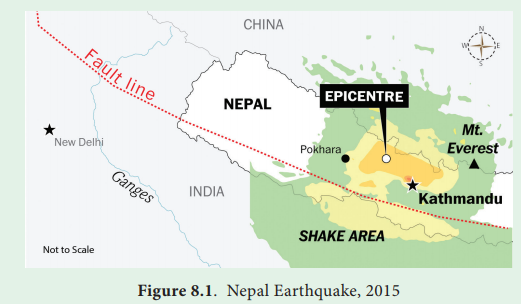Chapter: 11th Geography : Chapter 8 : Natural Disasters - Public Awareness For Disaster Risk Reduction
Earthquake - Disaster and Rules of actions during disasters
Disasters and Rules of actions during disasters
Earthquake
An earthquake is sudden, rapid
shaking of the ground caused by the shifting of rocks beneath the earth’s
surface. Earthquakes strike suddenly without warning and can occur at anytime.
The impacts of the earthquakes include deaths, injuries and damage of property.
You have learned about occurrence of the earthquake and other related
information in the earlier part of the book.
Nepal – India Earthquake
The April 2015 Nepal Earthquake (also known as the Gorkha
Earthquake) killed nearly
9,000 people and injured nearly 22,000. It occurred on 25 April, with a
magnitude of 8.1 Richter scale. Its epicentre was east of Gorkha District at
Barpak. It was the worst natural disaster to strike Nepal since 1934
Nepal–Bihar earthquake.

The earthquake triggered an avalanche
on Mount Everest, killing 21 people making April 25, 2015 the deadliest day on
Nepal’s history. The earthquake triggered another huge avalanche in the
Langtang Valley, where 250 people were reported missing.
Mock drill: Earthquake.
In case we are inside the class when
earthquake occurs, instruct loudly “earth quake position – drop, cover, and
hold on”. Drop down on your knee. Cover your head, neck and face. Go under a
table to protect your head.
Rules of actions during an earthquake:
1.
Stay calm, do not panic.
2.
If you are in a building, sit down on the floor under a table or any
other furniture and firmly hold on to it until the earthquake has stopped.
3.
If there is no table nearby, cover your face and head with your hands
and sit on the floor in a corner of the room.
4.
Keep away from glass windows, glass doors and things that can fall down.
5.
Do not try to leave the building quickly; during earthquakes people
mostly die because they try to run out of the building and become trapped under
ruins if the building is destroyed.
6.
Do not go to the staircase, a balcony or an elevator.
7.
If you are in the street, keep away from buildings; try to get into an
open space and avoid power transmission lines.
8.
If you are at home, turn off electrical equipment and gas quickly.
9.
If you are in chemistry class or a laboratory where chemicals are
stored, try to leave the room because chemicals may cause injuries;
After earthquake:
1.
First check if you have any injuries, and then check the condition of
the surrounding people. If you cannot do this, wait for the rescue team;
2.
After the earthquake when you leave the shelter, do not return for 2-3
hours because the quakes may repeat (an aftershock).
3.
Check if there is fire; in case of a mild one try to extinguish it.
4.
Be cautious about the possibility of gas leakage and damage caused to
electrical wiring.
5.
Be careful while opening wardrobe doors to take necessary items;
6.
Use only lanterns; do not use an oil lamp or a candle.
7.
Listen to the radio to receive information about the earthquake.
Related Topics